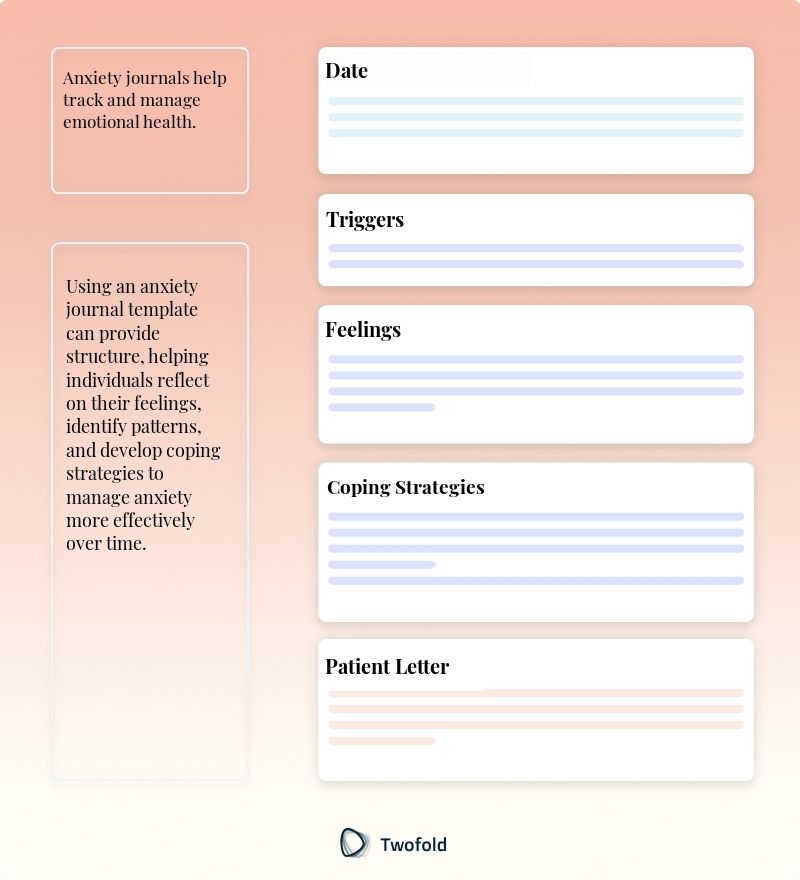
Anxiety Journal Template
Feeling overwhelmed by anxiety can often make it tough to keep your thoughts organized and focused. It’s not unusual to feel a bit lost, wondering how to manage those swirling thoughts and emotions. An anxiety journal template might just be the ideal solution to help you sort through your feelings, track triggers, and cultivate a sense of calm. If you've been searching for a structured way to address anxiety, read on!
What Is a Anxiety Journal Template?
An anxiety journal template is a structured document that assists individuals in logging their anxiety‑related thoughts and experiences. By providing a clear format, it encourages consistent entries and helps in capturing critical emotional insights.
The template typically includes sections for identifying triggers, describing emotional states, and noting coping mechanisms, making it easier for users to track their progress over time.
Key Components of a Anxiety Journal Template?
A well‑designed anxiety journal template should include the following key components:
- Date and time of the entry
- Identified triggers or situations causing anxiety
- Description of feelings and thoughts at the moment
- Coping strategies employed
- Reflection on what worked and what didn’t

How to Use a Anxiety Journal Template: Step-by-Step Process
- Download or create your anxiety journal template.
- Set a specific time each day to reflect and write.
- Begin with the date and time of your entry.
- Identify your triggers for the day.
- Detail your feelings and thoughts in response to those triggers.
- Document any coping strategies you used.
- Reflect on the effectiveness of those strategies.
- Close the entry with any additional insights or thoughts.
Benefits of a Anxiety Journal Template
Benefit | Description |
|---|---|
Improved Awareness | Recognizing triggers and responses helps in managing anxiety. |
Enhanced Coping Strategies | Identifying what works and what doesn’t allows for better responses in the future. |
Emotional Processing | Writing helps in processing emotions and reducing their intensity. |
Progress Tracking | Regular journaling provides a clear path of progress over time. |
Structured Reflection | Encourages structured thought processes rather than chaotic emotional responses. |
Stakeholders in Anxiety Journal Template
The anxiety journal template can benefit various stakeholders who play a role in mental health support:
- Patients: An individual struggling with anxiety can clearly see their patterns of thought and behavior, making it easier to communicate with their healthcare provider.
- Therapists: Mental health professionals can gain insights from the journal entries, tailoring their therapeutic approach based on documented triggers and responses.
- Family Members: Family can understand the struggles a loved one is facing, fostering empathy and support in daily situations.
- Support Groups: Group members can share insights or recommendations based on common entries, enhancing collective coping strategies.
Example of a Anxiety Journal Template
Here’s a sample structure of what an anxiety journal template may include:
- Date:
- Trigger:
- Feelings:
- Coping Strategy Used:
- Effectiveness:
- Additional Notes:
Real-World Use Cases: Practical Impact of the Anxiety Journal Template
The anxiety journal template can serve numerous practical purposes in real‑life scenarios:
- Exam Anxiety: a teenager documenting anxiety before exams can pinpoint specific triggers and cope better by practicing relaxation techniques.
- Work Related Stress: a working professional identifying work-related stressors can initiate conversations with their manager about workload balance.
- Life Changes: an individual preparing for an important life transition (like moving) can track fluctuations in anxiety levels, helping to create a plan to stay grounded.
- Improving Quality of Care: a person in therapy can equip their therapist with comprehensive insights, forming a stronger therapeutic alliance based on shared knowledge.
Conclusion
This exploration of the anxiety journal template highlights its practical benefits and the significant role it plays in managing anxiety. By capturing triggers, feelings, and effective coping strategies, users can not only track their emotional health but also foster greater self‑awareness. Engage with this tool to streamline your thoughts and pave the way for a more manageable day‑to‑day experience.
Disclaimer: This article is for informational purposes only and does not constitute legal or medical advice. Always consult professional guidelines and regulatory bodies for specific compliance requirements.

Dr. Danni Steimberg
Dr. Danni Steimberg is a pediatrician at Schneider Children’s Medical Center with extensive experience in patient care, medical education, and healthcare innovation. He earned his MD from Semmelweis University and has worked at Kaplan Medical Center and Sheba Medical Center.
Anxiety journal notes should do more than just track emotions—they should reveal patterns, triggers, and progress over time. A well‑structured approach enhances clinical insights, supports accurate coding, and strengthens treatment planning.
- Identify Trigger-Response Chains: Instead of vague descriptions like "felt anxious today," document specific triggers and physiological responses. Noting that a social event caused chest tightness and dizziness (F41.1 for Generalized Anxiety Disorder) helps tailor interventions like exposure therapy or mindfulness training.
- Quantify Anxiety Levels: Use a 1–10 scale or physiological markers (heart rate, breathing rate) to measure severity. Tracking fluctuations over days or weeks justifies adjustments in therapy frequency (e.g., increasing sessions coded under CPT 90834) or medication management.
- Summarize Patterns with “AIM”: Conclude each entry with Awareness (what insight was gained?), Interventions (what coping strategies were used?), and Movement (what progress or setbacks occurred?). This structured reflection not only helps patients but also provides clinicians with clear data for assessing treatment effectiveness.
Frequently Asked Questions
Reduce burnout,
improve patient care.
Join thousands of clinicians already using AI to become more efficient.

Social Work Treatment Plan Template
Discover practical Social Work Treatment Plan templates to enhance your documentation efficiency.

Patient Demographics Template
Discover practical Patient Demographics templates to enhance your documentation efficiency.

Client Feedback Form Template
Discover practical Client Feedback Form templates to enhance your documentation efficiency.


